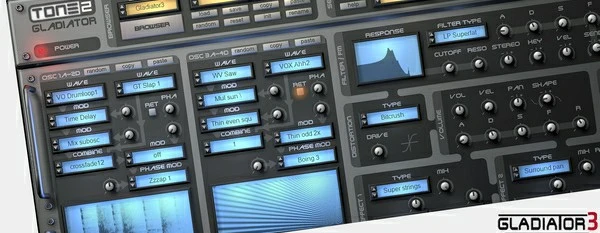
Gladiator, an acclaimed synthesizer, has become a staple in professional music production due to its innovative sound creation capabilities. This synth boasts an exclusive High-Complexity Modulation (HCM) synthesis method, paving the way for fresh and distinctive sonic experiences. In this article, we delve into the latest version, Gladiator 3.5.4, highlighting its new features, improvements, and native support for Apple M1 ARM processors on Mac.
New Features of Gladiator v3.5.4: Elevating the Synthesis Experience
Enhanced GUI for High-Resolution Screens: Gladiator 3.5.4 introduces a spacious GUI optimized for WQHD and 4K screens, providing a visually stunning and user-friendly interface.
Flexible Interface Sizes: Users can now choose from six different interface sizes, including small, medium, and large variants, with or without an editor. This versatility ensures an optimal viewing experience for every user.
VST3 Version for Mac: Gladiator now offers a VST3 version specifically designed for Mac, supporting both M1 native and Intel processors. This widens its compatibility and performance capabilities.
Standalone Version for Mac: The standalone version of Gladiator is now available for Mac, catering to both M1 and Intel processors, allowing users to enjoy the synth without a DAW.
Revamped AudioUnit Interface: Gladiator’s AudioUnit interface has been completely overhauled to provide a seamless experience on Mac, supporting both M1 and Intel processors.
Patch Browser Convenience: Users can now access the patch browser in three different sizes, ensuring a customizable and efficient browsing experience.
Mouse Wheel Menu Selection: Menu items can be swiftly selected using the mouse wheel, streamlining navigation within the synth.
DAW Automation: All parameters in Gladiator are now accessible for DAW automation, granting producers greater control over their sound.
HiDPI Font Support: The patch browser now supports HiDPI fonts, enhancing readability and aesthetics.
Version Information: The “Show version information” feature displays the plugin’s running mode (ARM or Intel) for easy identification.
Improvements: Enhancing User Experience
Subtle 3D GUI Knobs: The 3D effect on GUI knobs has been refined to provide a more visually appealing and user-friendly interface.
Convenient GUI Resizing: Resizing the GUI can now be accomplished through a more user-friendly list selection.
Enhanced Spectrum Displays: Gladiator now features spectrum displays with higher contrast ratios, aiding in visual analysis.
Swift Boot Times: Users of Macs with M1 processors can enjoy significantly faster boot times in Gladiator.
Native M1 Support: Gladiator’s native support for M1 processors results in a 20% reduction in CPU load compared to Rosetta2 mode, accompanied by a more responsive GUI.
Fine-Tuned Handles: The position of handles within Gladiator has been fine-tuned for precise control.
Numerous Small Improvements: Gladiator 3.5.4 incorporates numerous minor enhancements to enhance the overall user experience.
Corrections: Ensuring Reliability
Compatibility Fixes: Various small compatibility fixes have been implemented for macOS 11 and macOS 12.
AudioUnit Verification Workaround: A workaround has been introduced to address Apple’s unreliable AudioUnit verification process, eliminating the need to restart your Mac after installation.
VST3 Plugin Resizing: Workarounds have been applied for DAWs that incorrectly resized the VST3 plugin.
VST3 Automation Fix: Automation in the VST3 version now functions correctly for parameters located beyond the 10th slot.
Ableton and FL Studio Fixes: Issues with Ableton and FL Studio not adhering to the AudioUnit2 standard have been resolved.
Reaper Bug Fixed: A bug affecting automation options in Reaper has been fixed.
GUI Performance Improved: An issue leading to poor GUI performance over time has been addressed, reducing the likelihood of crashes.
Changes: Universal Compatibility
Universal Binaries: Both the AudioUnit and VSTi versions of Gladiator are now universal binaries, supporting 64-bit Intel and M1 processors seamlessly.
End of 32-bit Intel Support: Due to Apple’s development tools limitations, Gladiator no longer supports 32-bit Intel binaries with M1 support.
System Requirements: Apple Notarization and M1 support now require macOS 10.11 or later. Users with older macOS versions should stick with Gladiator 3.0.
Leave a Reply